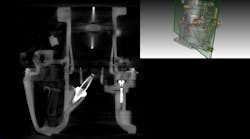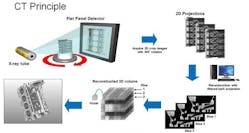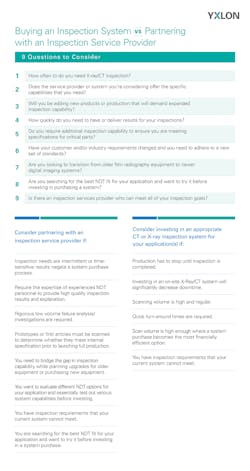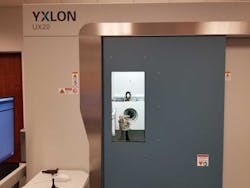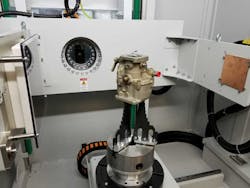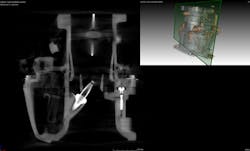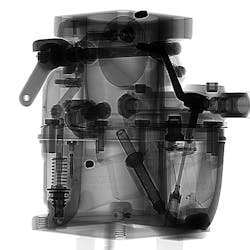When manufacturing products for aerospace, automotive, electronics or a variety of other applications, testing or inspection in some form is critical to ensure that the products meet quality and regulatory standards as well as end-customer expectations. To certify that the structural and mechanical components will be able to function safely, reliably and cost-effectively for the mission-critical applications in these industries, the use of non-destructive testing (NDT) is ideal. NDT does not require that a part be altered or destroyed during inspection, which saves both time and money in evaluation, troubleshooting and research.
In addition to X-ray, other forms of non-destructive inspection include ultrasonic, visual and optical; magnetic-particle; penetrant; eddy-current; and low-coherence interferometry testing. In many cases digital radiography (DR) and computed tomography (CT) are the top choices for NDT because of their diverse range of applicability, ease-of-use and powerful visualization capabilities.
When choosing between DR and CT, it is important to understand the differences in capability between the techniques. DR offers a quick and effective way to visualize internal features and defects and make simple measurements of a sample by digitally displaying real-time, 2D projection X-ray images. CT expands on the X-ray technology by synthesizing 3D volumetric datasets to enable precise virtual cross-sectioning of the part. The resultant data provides superior contrast, advanced volumetric measurement capability and quantitative density characterization.
In order to produce an effective CT reconstruction, CT scanners collect a series of 2D X-ray images at predetermined rotational steps, usually through 360 deg. After the 2D projections are compiled, the system begins reconstruction and “tomograms” are created for each row of pixels on a digital X-ray detector. Tomograms are virtual slices through a 3D object composed of voxels (volumetric pixels). The reconstruction process then assigns each voxel a gray value that corresponds to the actual density of the of the object at that location. The higher or brighter the gray value, the denser the material.
The final CT dataset enables visualization of slices (virtual cross-sections) at any desired angle, allowing the operator to scroll through the part in any plane in real time. Additionally, volume renderings are constructed automatically in the CT analysis software by assigning a color and opacity to each voxel that scales according to their gray value. These renderings of external and internal geometries of an object provide sophisticated and photorealistic visualization with adjustable shadows, transparency, camera angles, video creation and more.
CT scanning is widely used for a wide range of applications, including material analysis, defect recognition, failure analysis, statistical process control, metrology, assembly verification, image-based finite element analysis, reverse engineering and counterfeit detection. Many manufacturers also use CT to help fine-tune production parameters for die casting and additive manufacturing since it shows internal problems such as porosity, cracks, inclusions and foreign objects in blind cavities.
System Investment vs. Service Partners
X-ray and CT systems can be a significant and worthwhile investment when integrated into traditional production lines, research and development labs, and quality control. Additionally, it is becoming more commonly used in-line or at-line in smart manufacturing facilities. However, if a facility does not need to inspect products regularly or volume of inspection is low, purchasing X-ray/CT systems may not be the right option. Alternatively, partnering with an inspection services provider may be a more efficient and cost-effective decision by leveraging the skills and expertise of knowledgeable NDT professionals.
Inspection service capabilities for common NDT applications in the automotive industry include visualization and quantification of porosity, shrinkage and inclusions, wall thickness measurements and detection of foreign objects in castings. Additionally, identification of defects or missing wires in belt plies for tires and verification of air inclusions, shifts and distortions in the reinforcement plies are also common.
For the aerospace industry, a vast range of components can be effectively inspected by X-ray and CT inspection service providers, including turbine blades, flight hardware/sensors, welded components and more. In the electronics industry, solder quality, BGA inspections, wire bond defect detection, trace connectivity and visualization, and through-hole solder fill are all common inspection projects for inspection service providers.
What to Look for in an Inspection Services Provider
Inspection services providers can often offer more than simply generating 2D and 3D images by scanning your product or components. Service providers may also be able to offer:
- Support in development of specific solutions and testing procedures
- Fact-based recommendations and techniques tailored to meet your inspection goals
- Personal expert level support in data preparation, visualization and analysis
- Additional support during workload peaks or capacity bottlenecks
- Inspection of high-density and oversized items with high power linear accelerator X-ray systems
- Precise dimensional measurements for internal and external features and structures
- Workshops, seminars and training for your personnel
Inspection systems and inspection services vary greatly across manufacturers and service providers. However, a manufacturer of industrial X-ray systems that also offers inspection services has unparalleled depth of experience and capability by leveraging the optimal use of its own technologies. Once the decision to use inspection services has been made, there are a variety of items to consider when selecting which service provider to use.
First is capability. It may seem like a basic concept, but only consider a partner that can provide the specific set of capabilities that you need. Next is pricing. Compare prices from multiple service providers for the services that you need; do not hesitate to request quotes from multiple providers for the same project. Some companies even offer free quoting and feasibility tests.
Complete a trial project to evaluate the quality of image that each provider’s equipment offers. Having scans conducted on the same sample by multiple providers can help you make a fair comparison of image and data quality. Along with the equipment they use, a service provider’s personnel are also important to the quality of your inspection so investigate the level of training of the team members who will perform the scan. Most providers work within international standards such as ISO or ASTM. Many systems—regardless of manufacturer—use the same software to provide results, therefore the skill of the operator can truly differentiate one provider from another.
Remember to factor in shipping time if not already included in the quoted turnaround times from the providers. Service providers with multiple locations may be capable of performing scans more quickly and provide better shipping times due to flexibility of location. For companies with a global need for inspection services, using a global service provider is also a good decision.
Also, investigate the service provider’s equipment. Some companies readily provide descriptions and details of their inspection systems to prospective customers. Generally, the newest systems will provide the highest resolution and produce the best images. Providers should update their equipment and software regularly.
What to Expect from the Inspection Process
The inspection service process is typically straightforward; however, some complicated projects may require additional steps in the process.
Before sending parts for a trial, the inspection service provider will need to know part dimensions, part materials and a brief description of the inspection needed and desired outcomes. If there are any specific requirements, such as visualizing porosity of 0.5 mm or greater, this information is provided in this step. Next, the provider will send a quote. If there is a question about whether the provider can meet your inspection goals or if the project is not easy to quote, the provider should offer a feasibility test.
Feasibility testing requires one representative test sample to be sent in order for the provider to demonstrate the level of data quality to expect for the entire project. Typically, they will provide images of a region of interest relevant to the inspection to give confidence in their capability.
Sample delivery, test execution and results delivery are the next step, and this process varies from provider to provider. As an example of a typical process, when industrial X-ray inspection system manufacturer Yxlon’s inspection services team receives a part, it takes about one to two weeks to deliver results for smaller projects. Data delivery options include sending files via FTP or, for large data sets, external hard drives may be provided. Yxlon can provide a free viewer for CT visualization, image stacks of the slices in JPEG or TIFF files, or slice projection/volume rendering movies.
The provider will then work with you to ship back the parts or dispose of the samples depending on your need. Inspection services can provide valuable data and insights for a range of product applications, and choosing to invest in an inspection system or partnering with an outside inspection service provider is the first step.
Nathan Serafino is an applications engineer at Yxlon.
